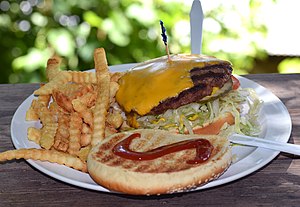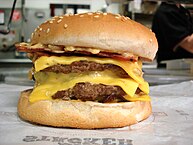Cheeseburger
 Cheeseburger served with French fries | |
| Course | Main course |
|---|---|
| Place of origin | United States |
| Serving temperature | Hot |
| Main ingredients | Ground beef patty, cheese, bun |
A cheeseburger is a hamburger topped with cheese. Traditionally, the slice of cheese is placed on top of the meat patty. The cheese is usually added to the cooking hamburger patty shortly before serving, which allows the cheese to melt. Cheeseburgers can include variations in structure, ingredients and composition. As with other hamburgers, a cheeseburger may include toppings such as lettuce, tomato, onion, pickles, bacon, mayonnaise, ketchup, and mustard.
In fast food restaurants, the cheese used in cheeseburgers is usually processed cheese. Other meltable cheeses may be used as alternatives. Common examples include cheddar, Swiss, mozzarella, blue cheese, and pepper jack.
Origins[]
By the late 19th century, the vast grasslands of the Great Plains had been opened up for cattle ranching. This made it possible for many Americans to consume beef almost daily. The hamburger remains as one of the cheapest sources of beef in America.[1]
Adding cheese to hamburgers became popular in the late-1920s to mid-1930s. There are several competing claims as to who created the first cheeseburger. Lionel Sternberger is reputed to have introduced the cheeseburger in 1926 at the age of 16. He was working as a fry cook at his father's Pasadena, California sandwich shop, "The Rite Spot", and "experimentally dropped a slab of American cheese on a sizzling hamburger."[2][3][4][5][6] An early example of the cheeseburger appearing on a menu is a 1928 menu for the Los Angeles restaurant O'Dell's which listed a cheeseburger smothered with chili for 25 cents.[7][8][9]
Other restaurants also claim to have invented the cheeseburger. For example, Kaelin's Restaurant in Louisville, Kentucky, said it invented the cheeseburger in 1934.[10] One year later, a trademark for the name "cheeseburger" was awarded to Louis Ballast of the Humpty Dumpty Drive-In in Denver, Colorado.[11] According to Steak 'n Shake archives, the restaurant's founder, Gus Belt, applied for a trademark on the word in the 1930s.[12][13][14]
The steamed cheeseburger, a variation almost exclusively served in central Connecticut, is believed to have been invented at a restaurant called Jack's Lunch in Middletown, Connecticut, in the 1930s.[15]
The largest cheeseburger ever made weighed 2,014 pounds (914 kg). It is said to have included "60 pounds (27 kg) of bacon, 50 pounds (23 kg) of lettuce, 50 pounds (23 kg) of sliced onions, 40 pounds (18 kg) of pickles, and 40 pounds (18 kg) of cheese." This record was set in 2012 by Minnesota's Black Bear Casino, smashing the previous record of 881 pounds (400 kg).[16]
In the United States, National Cheeseburger Day is celebrated annually on September 18.[17]
Ingredients[]

The ingredients used to create cheeseburgers follow similar patterns found in the regional variations of hamburgers, although most start with ground beef. Common cheeses used for topping are American, Swiss, and other meltable cheeses. Popular toppings include lettuce, tomato, onion, pickles, bacon, avocado or guacamole, sliced sautéed mushrooms, cheese sauce or chili, but the variety of possible toppings is broad.
A cheeseburger may have more than one patty or more than one slice of cheese—it is reasonably common, but by no means automatic, for the number to increase at the same rate with cheese and meat interleaved. A stack of two or more patties follows the same basic pattern as hamburgers: with two patties will be called a double cheeseburger; a triple cheeseburger has three, and while much less common, a quadruple has four.[18][19] A burger with 20 patties is called a score burger.
Sometimes cheeseburgers are prepared with the cheese enclosed within the ground beef, rather than on top. This is sometimes known as a Jucy Lucy.[20]
Religious[]
Traditionally, this dish breaches the kosher laws (Hebrew: כַּשְׁרוּת; kashrut) observed by Judaism as it combines ground beef and cheese. Mixtures of milk and meat (Hebrew: בשר בחלב, basar bechalav, literally "meat in milk") are prohibited according to Jewish religious law (Hebrew: הלכה; halakha), following a verse in the Book of Exodus in which Jews are forbidden from "boiling a (kid) goat in its mother's milk" (Exod. 34:26).[21][22] This prohibition appears again in Deuteronomy.[23] This dietary law sparked controversy in Jerusalem when McDonald's began opening franchises there that sold cheeseburgers.[24] Since that time, McDonald's has opened both kosher and non-kosher restaurants in Israel.[25]
In an attempt to provide a "kosher cheeseburger", a kosher restaurant in New York City created a controversial cheeseburger variation which replaces cheese with soy cheese.[26]
Gallery[]

A Burger King "Quad Stacker" cheeseburger, containing four patties and bacon

A cheeseburger at a restaurant in Camden Town, London

A half-eaten McDonald's Big Mac, showing the contents of the burger.
See also[]
 Food portal
Food portal
References[]
- ^ Ozersky, Josh (2008). The Hamburger: The History. New Haven Conn.: Yale University Press. pp. 12, 14. ISBN 9780300117585.
- ^ Piasecki, Joe (January 16, 2012). "Pasadena claims its slice of burger history". Los Angeles Times. ISSN 0458-3035. Retrieved October 15, 2017.
- ^ Harvey, Steve (March 27, 1991). "Only in L.A." Los Angeles Times. p. B2.
Cooking at his father's short-order joint in Pasadena in the early 1920s, [Sternberger] experimentally tossed a slice (variety unknown) on a hamburger...
- ^ Perry, Charles (June 9, 2004). "It's an L.A. Thing; Our burgers are the best with good reason: We made them here first". Los Angeles Times. p. F1. Archived from the original on October 25, 2012. Retrieved May 13, 2012.
- ^ Piasecki, Joe (January 13, 2012). "Yes, it was invented in Pasadena! Probably. Tracing the cheeseburger from inception to Bob's Big Boy". Pasadena Sun. Archived from the original on January 29, 2012. Retrieved May 13, 2012.
- ^ Henerson, Evan (June 23, 1999). "The Tale of the Cheeseburger". San Gabriel Valley Tribune. Archived from the original on April 12, 2003. Retrieved May 13, 2012.
- ^ Grace, Roger M. (January 15, 2004). "Old Menus Tell the History of Hamburgers in L.A." Metropolitan News-Enterprise. Retrieved May 13, 2012.
- ^ Spiers, Katherine (September 18, 2013). "Were Cheeseburgers Invented in Pasadena?". KCET. Retrieved December 8, 2014.
- ^ "O'Dell's menu". Menu Collection. Los Angeles Public Library. 1928. Archived from the original on October 28, 2017. Retrieved October 28, 2017.
- ^ "Louisville Facts & Firsts - LouisvilleKy.gov". City of Louisville, Kentucky. Archived from the original on October 6, 2014. Retrieved July 29, 2006.
- ^ "History of the Cheeseburger". Cheese-Burger.net (blog). Archived from the original on August 2, 2018. Retrieved October 2, 2008.
- ^ Flick, Bill (February 20, 2012). "Flick Fact 2/20/2012 Monday". Bloomington Pantagraph. Archived from the original on September 11, 2012. Retrieved February 21, 2012.
- ^ "Our 'Top 5 List' of little-known facts about Bloomington-Normal". WJBC-FM. July 29, 2011. Archived from the original on December 2, 2011. Retrieved February 21, 2012.
- ^ Perry, Catherine D. (July 7, 2004). "Steak 'n Shake vs Burger King, Memorandum and Order" (PDF). United States District Court Eastern District Missouri Eastern Division. Archived from the original (PDF) on September 28, 2013. Retrieved February 21, 2012. (7 July 2004) 323 F. Supp.2d 983 (E.D. Mo. 2004)
- ^ George Motz (May 10, 2011). Hamburger America: Completely Revised and Updated Edition: A State-by-State Guide to 150 Great Burger Joints. Running Press. p. 70. ISBN 978-0-7624-4234-8.
- ^ Ulla, Gabe (September 4, 2012). "World's Biggest Cheeseburger Clocks in at 2,014 Pounds". Eater. Retrieved March 2, 2017.
- ^ "Free cheeseburgers! Where to find the meal deals for National Cheeseburger Day Tuesday". USA Today. September 18, 2018. Retrieved February 25, 2019.
- ^ Tice, Carol (January 28, 2002). "In-N-Out Burgers: With an emphasis on quality, this fast feeder shows its rare appeal. (Regional Powerhouse Chains)". Nation's Restaurant News. Archived from the original on December 7, 2014 – via Highbeam Research.
- ^ Hall, David (October 24, 2006). "Society's fast food intake reeks". Daily Skiff. Texas Christian University School of Journalism. Retrieved February 13, 2010.
- ^ Flower, Justin; Boller, Jay (March 13, 2008). "Burger Battle". Minnesota Daily. Archived from the original on July 10, 2009. Retrieved October 31, 2017.
- ^ Exodus 34:26
- ^ Exodus 23:19
- ^ Deuteronomy 14:21
- ^ Bronner, Ethan (September 3, 1995). "Big Mac under attack in Jerusalem As McDonald's rings up sales of nonkosher burgers, outcry on 'cultural identity' heard". Boston Globe. Retrieved August 21, 2010 – via ProQuest. Alternate link via ProQuest.
- ^ "Will residents of Jerusalem get to bite a kosher Big Mac?". J. The Jewish News of Northern California. December 21, 2001. Retrieved August 21, 2010.
- ^ Montefinise, Angela (March 2, 2008). "Jews Have A 'Beef'". New York Post. Retrieved May 30, 2014.
Further reading[]
| Wikimedia Commons has media related to Cheeseburgers. |
- Henerson, Evan (June 23, 1999). "The Tale of the Cheeseburger". San Gabriel Valley Tribune. Archived from the original on April 12, 2003.
- Nosowitz, Dan (July 6, 2018). "The Price of Cheeseburgers Has Gone Up". Modern Farmer. Retrieved February 25, 2019.
- Gilad, Elon (August 16, 2018). "Can Jews eat cheeseburgers after all?". Haaretz. Retrieved February 25, 2019.
- American sandwiches
- Hamburgers (food)
- Cheese sandwiches
- Culture of Pasadena, California
- Culture of Denver
- Fast food
- Cheese dishes
- Independence Day (United States) foods



